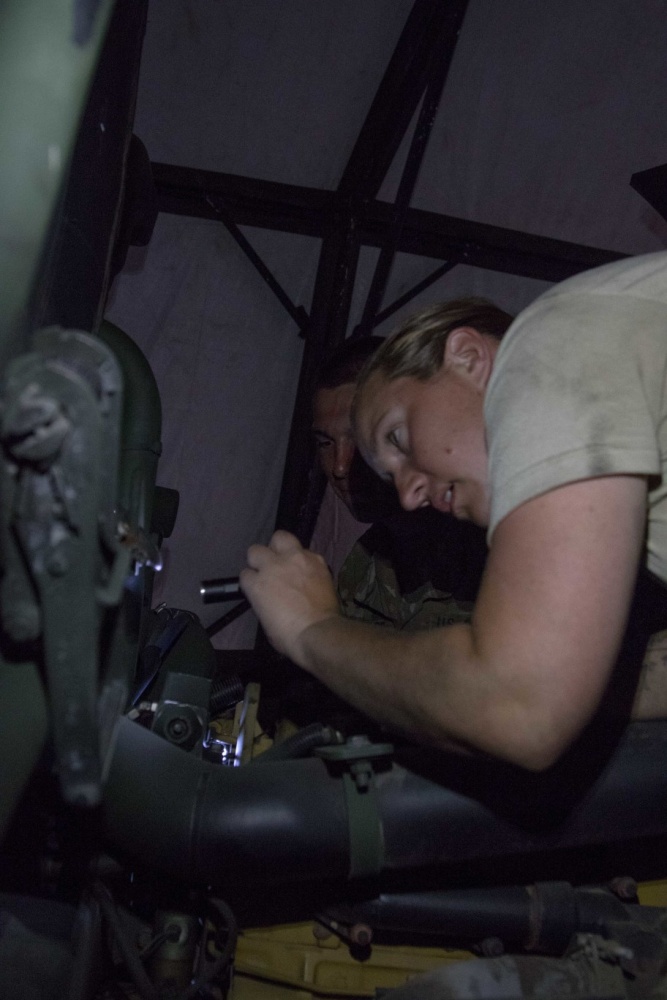 Photo By Sgt. Ariel Solomon | Sgt. Jennifer Bruner from Claremore, Okla. and Pfc. Thunder Sharp from Perkins, Okla., both with the 700th Brigade Support Battalion, Oklahoma National Guard, check for a short in the wiring of a Light Medium Tactical Vehicle at the Beaumont Regional Staging Area in Jefferson County, Texas, Sept. 9, 2017. The 700th BSB is coming in to relieve the Combined Maintenance crew.
Photo By Sgt. Ariel Solomon | Sgt. Jennifer Bruner from Claremore, Okla. and Pfc. Thunder Sharp from Perkins, Okla., both with the 700th Brigade Support Battalion, Oklahoma National Guard, check for a short in the wiring of a Light Medium Tactical Vehicle at the Beaumont Regional Staging Area in Jefferson County, Texas, Sept. 9, 2017. The 700th BSB is coming in to relieve the Combined Maintenance crew.
BEAUMONT, TX, UNITED STATES
09.10.2017
Story by Sgt. Ariel Solomon
128th Mobile Public Affairs Detachment
In disaster response operations, Soldiers depend on their vehicles to rescue stranded people and bring supplies to those in need. Flooding along the Gulf Coast of Texas following Hurricane Harvey placed significant strain on even the hardiest of military vehicles.
During these operations, Army mechanics and vehicle maintainers work around the clock to do their part to keep the rescue and recovery effort moving.
“You can tell some of these guys have been living in their trucks for three or four days,” said Sgt. Michael Shupak of the 736th Component Repair Company, Texas National Guard. “We put them in cots, give them drinks, food from the dining facility, whatever they need to be comfortable while we work on their trucks. When we’re done, they’re on the road again.”
The most common issue causing trucks to break down is water diluting the various oils used to lubricate moving parts within the vehicles, which makes parts break, bearings seize or engines overheat. When this happens, the vehicle is “deadlined” and unable to be sent back out on missions.
“The Soldiers are going above and beyond the capabilities of the vehicles when fording water,” said Sgt. Feraz Hosein with the 736th CRC, a native of Saginaw, Texas. “To rescue people, they have to do what they have to do.”
The Soldier’s Creed states that “I will always place the mission first,” and it doesn’t matter if their mission is rescuing civilians at the risk of damaging trucks or repairing those vehicles before preparing their own sleeping area.
“There wasn’t anything set up for us when we arrived and there were six vehicles that needed repairs,” said Sgt. Derwood Smelley with the 112th Quartermasters, Texas National Guard, a native of Hallsville. “We got to work before we got our own tent setup. We were up until 2 a.m. getting those trucks working.”
These Soldiers, from several different units, received the call and in a few days they came together as a team to accomplish their task. In total, the combined maintenance crew has repaired more than 40 vehicles, some of which are being sent immediately to Florida to help with the aftermath of Hurricane Irma.
“Overall, it was a really good mission and we accomplished a lot,” said Hosein. “We pushed to the limit, working 24 hours a day, late at night and everyone did awesome.”